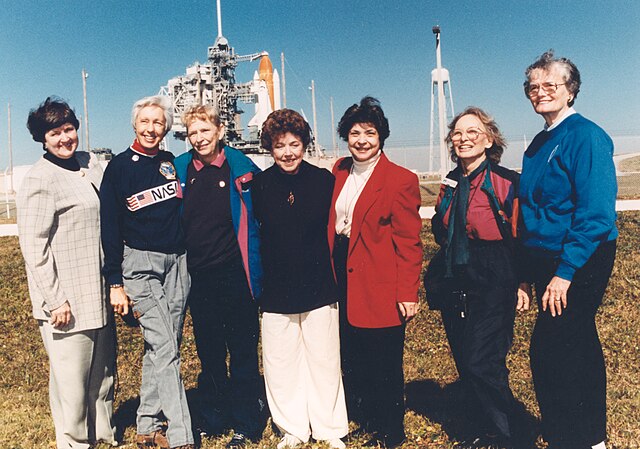Geraldyn M. Cobb , commonly known as Jerrie Cobb, was an American pilot and aviator. She was also part of the Mercury 13, a group of women who underwent physiological screening tests at the same time as the original Mercury Seven astronauts, and was the first to complete each of the tests.
Jerrie Cobb with a Project Mercury spacecraft
Jerrie Cobb operating the Multi-Axis Space Test Inertia Facility (MASTIF) at the Lewis Research Center in Ohio. The test simulated bringing a spinning spacecraft under control, and was one of many that the women of the Mercury 13 went through in order to qualify for space flight.
The Mercury 13 were thirteen American women who took part in a privately funded research program run by NASA physician William Randolph Lovelace II in 1959-1960, which aimed to test and screen women for spaceflight. The first participant, pilot Geraldyn "Jerrie" Cobb helped Lovelace identify and recruit the others. The participants successfully underwent the same physiological screening tests as had the astronauts selected by NASA for Project Mercury. While Lovelace called the project Woman in Space Program, the thirteen women decades later became known as the "Mercury 13"— a term coined in 1995 as a comparison to the Mercury Seven astronauts. The Mercury 13 women were not allowed in NASA's official astronaut program, and at the time, never trained as a group, nor flew in space.
Seven surviving FLATs attending the STS-63 launch (1995).(from left): Gene Nora Jessen, Wally Funk, Jerrie Cobb, Jerri Sloan Truhill, Sarah Ratley, Myrtle Cagle, and Bernice Steadman.
Jerrie Cobb with a Mercury capsule (c. early 1960s)
Mercury 13 astronaut Wally Funk flew a suborbital New Shepard spaceflight on July 20, 2021




